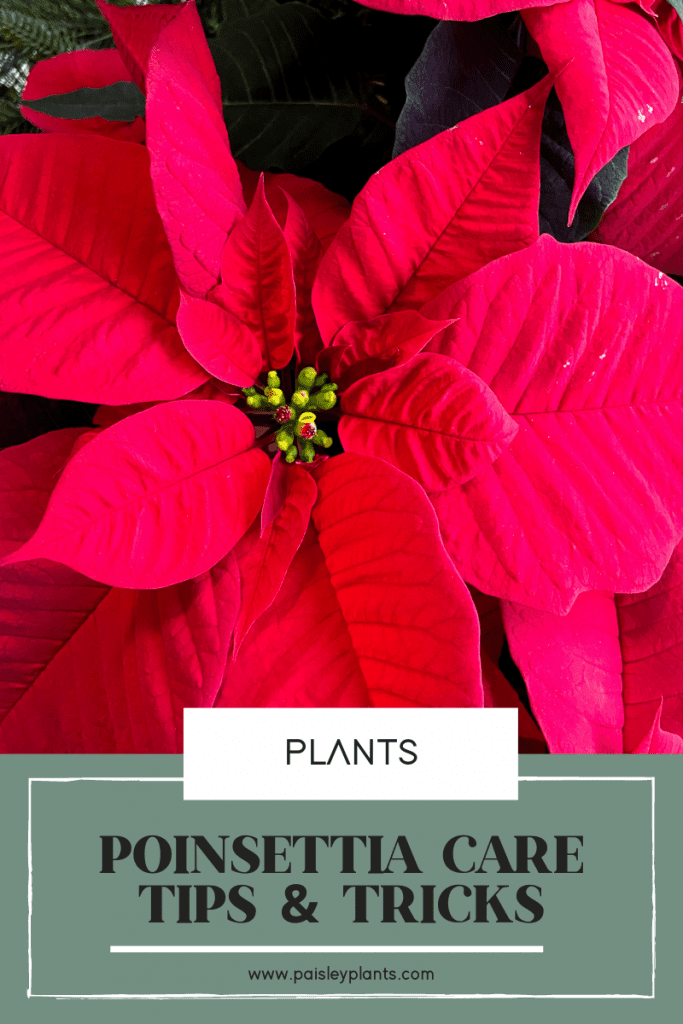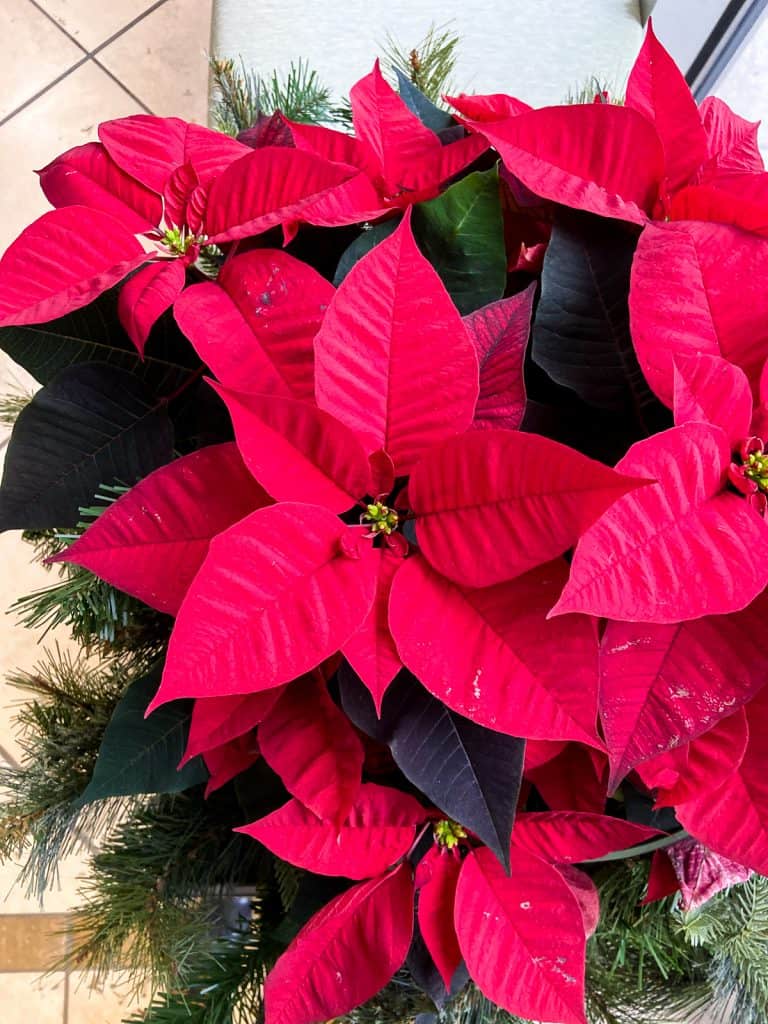Love poinsettias? Are you planning to take your Christmas theme a step further this year?
My grandma always got one (at a minimum!) poinsettia every year at Christmas time so these beautiful plants always bring back fond memories of her! After she passed I decided to carry on the tradition of getting a poinsettia every year in her honor.
Maybe you’re like me and get them for the winter holidays or maybe you love having these house plants around all year round, whatever your reason behind you buying poinsettias, you’re going to need all the help to care for them properly.
Not sure how to go about with the watering, potting, and pruning of this lovely Christmas plant?
I’ve got you — read on to find out everything about poinsettia, including its origins, varieties, and care tips.
Table of Contents
What Is a Poinsettia?

Poinsettia, the botanical name for which is Euphorbia pulcherrima, is a popular perennial shrub that grows about 3-10 feet tall and 3-7 feet wide.
It has deep green foliage with a cherry-red crown of leaf-like bracts. The poinsettia flowers are small yellow-colored and are placed at the top in the center of the bracts.
Those beautiful colorful bracts you see on the head of the poinsettia? They are not flowers but a modified variety of colorful leaves.
You might have seen some of the relatives of the poinsettia, such as the chenille plant, castor bean, crown of thorns, or the croton.
Where Did Poinsettia Originate From?
Poinsettias are tropical plants that originates from central America, mainly indigenous Mexico. It was first brought to the United States in the 1800s by Joel Roberts Poinsett, a botanist and the first U.S. ambassador to Mexico. That’s also why it’s called the ‘poinsettia.’
How Many Poinsettia Varieties Are There?
Yes, you read that right – there more than one variety! While it’s the most well-known variety, red is not the only poinsettia that you can find.
With successful poinsettia breeding, over 150 varieties of poinsettias exist. These include variegated varieties in a range of show stopping colors like pink, white, yellow, burgundy, purple, and more.
How Did Poinsettia Become the Christmas Flower?
The main reason for this is that the poinsettia blooms around Christmas time, and it helps that its bloom bears the Christmas colors of red and green.
But the earliest mention of the poinsettia and Christmas together is when the Ecke family decided to sell the plants. Paul Ecke Jr. is also known to have sent free poinsettias as holiday gifts to TV studios across the United States.
But the legends from Mexico tell a different story.
The most popular legend of the poinsettia is of a girl named Pepita. Without any money to buy gifts, Pepita was clueless about what to bring for baby Jesus for his birthday. Other versions of the legend talk about angels and more but always end up with Pepita picking up a bouquet of weeds and leaving them at the nativity scene. These weeds later transformed into spectacular red-colored poinsettias.
Where To Get a Poinsettia?
These days, poinsettias are widely available! Your best bet is to buy this popular holiday plant from a local nursery, florist or ordering them online from the same. Often times your local grocery stores carry poinsettias during the holiday season.
Make sure the plant has been given the proper TLC from the place you get it from though! How do you identify a healthy poinsettia? Look for the yellow flowers at their center. They should have tighter buds. You’ll also want to find plants that have deep green leaves as opposed to yellow leaves.
How To Care For A Poinsettia?
Let’s chat poinsettia care tips! Proper care will keep your plant happy and healthy throughout the Christmas season and for months and years to come!
Watering
Watering a poinsettia can be an easy yet tricky job. Your poinsettia needs to be watered just enough to maintain the moisture in the soil. This means you can neither give your poinsettia too much nor too little water.

One trick is by placing the plant directly in the kitchen sink under the tap. Run the water until the water starts running down the drainage holes at the bottom of the pot. Once the soil is completely saturated and the water has stopped running through the holes, place the pot back on its plate.
You can do this process once every week to ensure the soil’s water level is balanced.
Our tip?
Always keep an eye on the soil. Water only when the soil feels dry. Too much water can cause root rot but not enough water is also not good! An easy way to check this is by sticking a finger into the top of the soil. Is the soil dry? Your plant needs water. Is the soil damp? Wait a bit!
Make sure the pots you use have adequate drainage. If the water pools at the bottom it’s hard to see that on the soil’s surface.
Another way to test the water level is by looking at the leaves of a poinsettia. If the leaves turn yellow or fall off, you’re probably overwatering the plant.
Light
During the winter months, your poinsettia likes six to eight hours of bright, indirect light is what the poinsettia loves best. Your best solution is to keep the poinsettia in a sunny location like a south-facing window.
When the weather gets warmer, you can put the plant outdoors in a partly shaded spot.
Temperature and Humidity
The poinsettia thrives in a lower temperatures than you may think. A space where the daytime temperatures are between 65-75 degrees Fahrenheit and nighttime temperatures are above 60 degrees Fahrenheit.
Poinsettias love humid climates with plenty of moisture. So, your best bet is to place them in rooms with other plants to ensure the air is humid enough.
Avoid placing the poinsettia directly in the path of a cold draft such as too close to a cold window. They won’t be happy near cold air!
Soil
Plant your poinsettias using well-draining loamy soil. Your plant will do well if you mix three parts soil to one part grit. This combination helps oxygen reach the plant roots and air the soil, so excess water drains regularly.
The potting soil should have a neutral to acidic pH range between 5.8 and 6.2.
Fertilizer
You do not need to add fertilizers to a poinsettia during the growing season. Instead, you’ll need the fertilizers when spring arrives, and the growth seems to have halted. A water-soluble fertilizer is a great option.
How To Make a Poinsettia Last All Year?
Most people simply get rid of poinsettias along with their Christmas decorations. But, if you’re intent on keeping and caring for your poinsettia all year long, here are some tips to help you:
- Reduce the watering frequency from December to early spring
- Prune the plant around April
- Repot the poinsettia in a bigger pot and add new soil to it
- Place the pot in a dimmer, drier, and cooler place with a temperature of 55 degrees Fahrenheit
- Bring it back into a sunny spot when new growth appears
- Water the plant regularly from here on
- During summer, make sure to pinch back the stems about one inch to encourage growth (do this once again before summer ends)
How to Get a Poinsettia to Bloom on Time for Christmas?
Once October begins, you start using the short-day treatment to prepare the poinsettia for its Christmas bloom.
What is the short-day treatment, though?
Short-day treatment involves placing the plant in bright sunlight for 8-9 hours before keeping them in complete darkness for the next 15 to 16 hours. This treatment usually lasts for six to eight weeks. During this process, watering can be carried on as usual.
Once the bracts start to appear, you can halt the short-day treatment.
Poinsettias are short-day plants. This means that flowering occurs when the days are shorter and nights are longer. What does this mean for you?
If you’re not getting enough darkness during the colder months, your plant may not flower. In this case, place the poinsettia in total darkness like a dark room or dark closet at nighttime and bring it out during the day.
FAQ About Poinsettia
No, poinsettias are not toxic to most humans.
But the white sap of the poinsettia is known to cause allergic reactions in people with latex allergies. If you have cats and dogs at home, keep them from ingesting any part of the poinsettia.
Various conditions can affect the frequency of watering — water when the top two to three inches of the soil feels dry to touch.
On average, watering it once a week and leaving a few ice cubes in the soil should be enough (more on this below).
Many factors can cause poinsettia leaves to fall off. It may be due to the draft, stress, or the plant’s environment.
If you find your poinsettia leaves falling, move the plant to a cooler area with no draft. Check if it also gets adequate water.
Yes and no.
Poinsettias do best when watered with room temperature water. However, if you want to use ice cubes rather than room temperature water then leaving 6-8 ice cubes in the soil every day should help keep the plant hydrated.
Poinsettias should be set in a sheltered, warm spot out of direct sunlight and with a minimal breeze.
During the off-season, you can place the plant in a cool and dark spot and bring it to a south-facing window.
Whether you’re looking to add an ornamental plant to your collection or setting up Christmas decorations, the Poinsettia is a wonderful addition.
Caring for a poinsettia may be tricky at first. But once you follow our tips for using suitable soil, following a watering schedule, and using proper lighting, then you’ll surely enjoy growing them.
Do you have any special tips that you use to make your poinsettia bloom right before Christmas or any other care tips to grow a healthy poinsettia? Share your tips and tricks with us!

